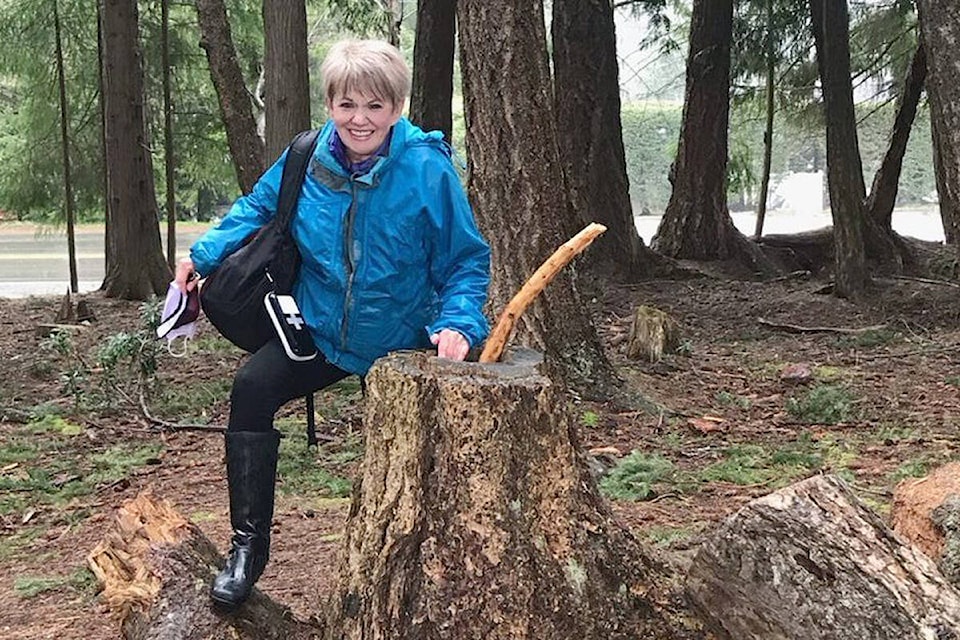Part 2 in a series
By Jennifer John
Homelessness is not a new phenomenon in the Parksville Qualicum Beach region, but several factors are shifting the issue to include a whole new population of residents.
“The past two years have been particularly hard with the COVID-19 pandemic,” said Doreen “Coco” Littlejohn, a outreach registered nurse. “We are seeing many people experiencing homelessness for the first time in their lives.”
Before Littlejohn began working with homeless residents in the PQB area, she spent more than 15 years working with the homeless population in Vancouver’s Downtown Eastside.
Littlejohn said that with inflation, rising rents, increased food costs, as well as a robust real estate market, people can no longer afford higher rents. The first article of this series, ‘The Changing Face of Homelessness’, covered the rising cost of living in the PQB region and the increased risk of homelessness for many citizens. According to Island Health’s Local Health Area Profile (2019), 49.9 per cent of renters in the region spend over 30 per cent — the national recommended guideline — of their income on rent, putting them at risk of homelessness. According to Homeless Hub, a web-based research library and information centre, “it has been unequivocally established that poverty and homelessness are strongly correlated.”
However, these housing statistics bridge with another local problem — access to primary healthcare.
The Centre for Disease Control and Prevention states that “social determinants of health are conditions in the places people live, learn, work and play that affect a wide range of health risks and outcomes.” Homeless Hub explains that “people experiencing homelessness, as a group, die younger than housed people and many suffer from more frequent severe illness at an earlier age.” It also states that homelessness presents a variety of barriers to individuals wanting to access healthcare, and this leads to a unique set of challenges.
Littlejohn describes the population she works with as “vulnerable.”
“They may have complex serious physical and mental health issues, addiction issues, complicated by structural issues,” she said.
That, compounded with the shortage of family physicians, nurse practitioners, and a lack of supports provided by integrated community care teams, makes it next to impossible for residents to receive the care they need, Littlejohn explained.
During the 2021 Point in Time homeless count (PiT) for the PQB region, 32 per cent of the homeless population reported having at least two health concerns, and 26 per cent reported living with at least three health concerns. Additionally, 58 per cent of the local homeless reported mental health challenges, and 49 per cent reported physical disabilities.
In Littlejohn’s experience, vulnerable residents who aren’t already connected to primary care services only seek care when it’s urgent.
READ MORE: The changing face of homelessness in Parksville Qualicum Beach
“Many of our clients only see a physician in emergency care when in acute care crisis. Transportation and access to low threshold barrier care is not readily available, creating additional challenges for our vulnerable population.”
Access to primary healthcare is not just a problem for the homeless. According to an article in the Parksville Qualicum Beach News in May 2019, 6,000 to 8,000 residents — housed or otherwise — are without a primary care practitioner. As cited in a 2022 PQB News article, the Parksville Chamber of Commerce stated: “The average family doctor carries a patient load of 1,500 to 2,000 patients.” Additionally, the average age of residents in the PQB region is 67.
“We do not have robust, well-staffed Geriatric Assessment Outreach Services,” said Littlejohn.
Creative solutions are needed to address the challenges of local homelessness through addressing both housing and healthcare. Homeless Hub expands on this by explaining that “efforts to do one without the other are doomed to fall short of addressing the real problem.”
Littlejohn explains that other municipalities, such as Nanaimo, offer very successful low-barrier primary outreach services called ‘Mobile Medical Care.’ Medicine Hat, Alta., has been successful in reaching a functional zero count in homelessness through efforts such as by-name lists of clients that all service providers in the community may access.
Littlejohn shares that there is a lack of local detox centres for those who need them. Although Forward House Community Society is working on opening an addiction recovery centre in Parksville, there is currently no detox centre in the PQB region.
The only shelter in the region, Ocean Place, is run by OHEARTS (Oceanside Homelessness Ecumenical Advocacy Response Team Society), and the waiting list is staggering. Orca Place, Parksville’s supportive housing shelter, provides 52 suites to vulnerable residents, including programs and supports, and it is also full.
In attempting to address the needs of the local homeless, Littlejohn said: “I have cried tears myself, but somehow I steel myself to go back out and fight for humane treatment of our most vulnerable. This work is my passion, and I will continue to seek solutions through advocacy and community support.”
Jennifer John is the Oceanside Task Force on Homelessness co-ordinator. This article has been produced through the efforts of the Union of BC Municipalities Strengthening Communities’ Services Grant.
